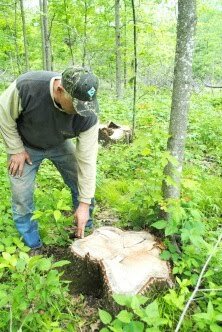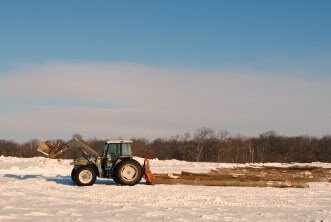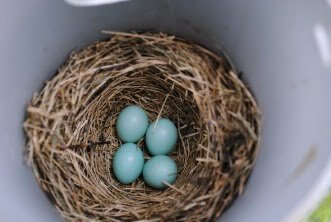“Allemande left, do sa do! Swing your partner, ‘round she goes!”
The art of square dancing is in how smoothly a person moves with their partner, moves away from that partner, and then moves back once again to the home position. For Mary and Bill Bailey, that description is about more than the dance. It’s about life.
Initially, visits to the Mayo Clinic brought Mary and husband Leonard to this area. “We just fell in love with the land and planned to retire here, having found the ideal 58 acre piece of property in 1992,” said Mary. “We established hiking trails and installed bluebird boxes, and finally moved to Chatfield from Indiana in 2002. Sadly, Leonard died suddenly just 2 years after we moved here. It was just devastating. I considered selling and moving back near family. Instead, I got lots of help and good advice from neighbors and friends and realized I couldn’t leave here.”
For Bill, who lost his first wife to cancer in 2006, leaving the area was never a consideration. “My great-grandfather homesteaded near here in 1884. The land I farm now with my brother Steve was bought by my grandfather in 1917, passed to my dad, and then on to us. On our 2000 acres we raise corn, soybeans, alfalfa, and a 200-head cow-calf herd. We also have 300 acres of woods that we manage, along with some woods that the cows rotationally graze, though I never met a cow that was much of a forester,” quipped Bill.
Mary watched a demo square dance during a local town festival and contacted one of the dancers about lessons. “It seemed like a good, safe way to meet people and socialize.” It also happened to be a good way to meet a new partner for life. Bill and Mary were married in September, 2008, and continue to square dance three to four times per week. So, how does this match made on the square dance floor end up as the 2015 Minnesota Tree Farmers of the Year? It really began in Bill and Steve’s childhood.
Growing up, I was always drawn to our woods. Of course, I spent a lot of time doing fieldwork, but being in the woods was my favorite thing to do,” said Bill. “When it came time to go to college, I decided I already knew enough about farming, so I got a degree in forestry from the U of M in 1971.” While Bill was still in college, he and Steve began to manage their woods by more intensely logging some areas, creating more trails and hand planting black walnuts. “In 1985, I wrote up our first real management plan. The idea evolved to log 30 acres every year, which means we’re back in an area every 10 years. We’re pretty aggressive in thinning and selecting crop trees. Every year, our goal is to harvest 100,000 board feet,” said Bill. According to Steve, “thinning is one of the best things you can do for the environment. A young tree takes in more carbon dioxide than the fully mature trees, just like a young man utilizes more nutrients compared to an old man.”
The Baileys have hosted field days on their property and have a unique way to show the advantages of thinning. “One of my favorite things I’ve shown people is a wedge I cut from a basswood we harvested in 2014,” said Bill. The area around the tree was thinned in 1984 and again in 2000. Bill used colored pins to show the impact of thinning on growth rate. The first 35 years of growth resulted in 9% of the total volume of the tree. In the 16 years after thinning in 1984, the tree added 26% of its total volume. Fourteen years of growth from 2000 to 2014 resulted in 65% of the total volume. “Many woodland owners are missing out on a great opportunity if they don’t thin their stands,” said Bill. “You need to thin out that low-value tree in a timely manner to give your more valuable ones room to grow!” Even though Bill has a forestry background, he recommends building a relationship with a local forester. “DNR forester Jim Edgar has really helped us a lot with advice and expertise, and that would be even more important for someone new to forest management. It’s a good investment to find a reputable forester to oversee your timber sale.”
With chainsaws, tractors, a Finnish-built PTO winch and occasionally a rented skidder, Steve and Bill spend their winters in the woods, thinning and harvesting a wide variety of species: black walnut, hard maple, red, white and burr oak, red and gray elm, cherry, basswood, poplar, ash, hackberry and cottonwood. “Keeping the forest healthy is kind of like healthy eating,” said Steve Bailey. “No matter how good one food is, if you only eat that one, it’s not going to be healthy. That’s why we have lots of different tree species, because that’s more healthy.” Root River Hardwoods of Preston and Albert Lea, MN, grades and marks the logs for length, with most of them going to local Amish sawmills for pallet production. Premium logs are used for veneer, flooring, barrel staves, and finish wood sold in commercial stores.
By the way, any article about the Baileys would be remiss if it didn’t mention two other things. First, a large portion of the six-mile Lost Creek Hiking Trail meanders through their land. Opened in October of 2011, the trail is maintained by the Bluff Country Hiking Club, and the Bailey’s cooperation and enthusiasm was crucial to the success of the project. Complete with educational signs, the trail is a wonderful marriage of recreation and forest education. Second, there’s this thing about Mary and bluebirds. For more information on that, see the article on the Bluebird Recovery Program in this issue.
For their efforts in conservation, public education, forest improvement, and making their woodlands available to the public for recreational activities, Steve Bailey, and Bill and Mary Bailey are certainly worthy recipients of the Tree Farmer of the Year award and an inspiration to all woodland owners.





